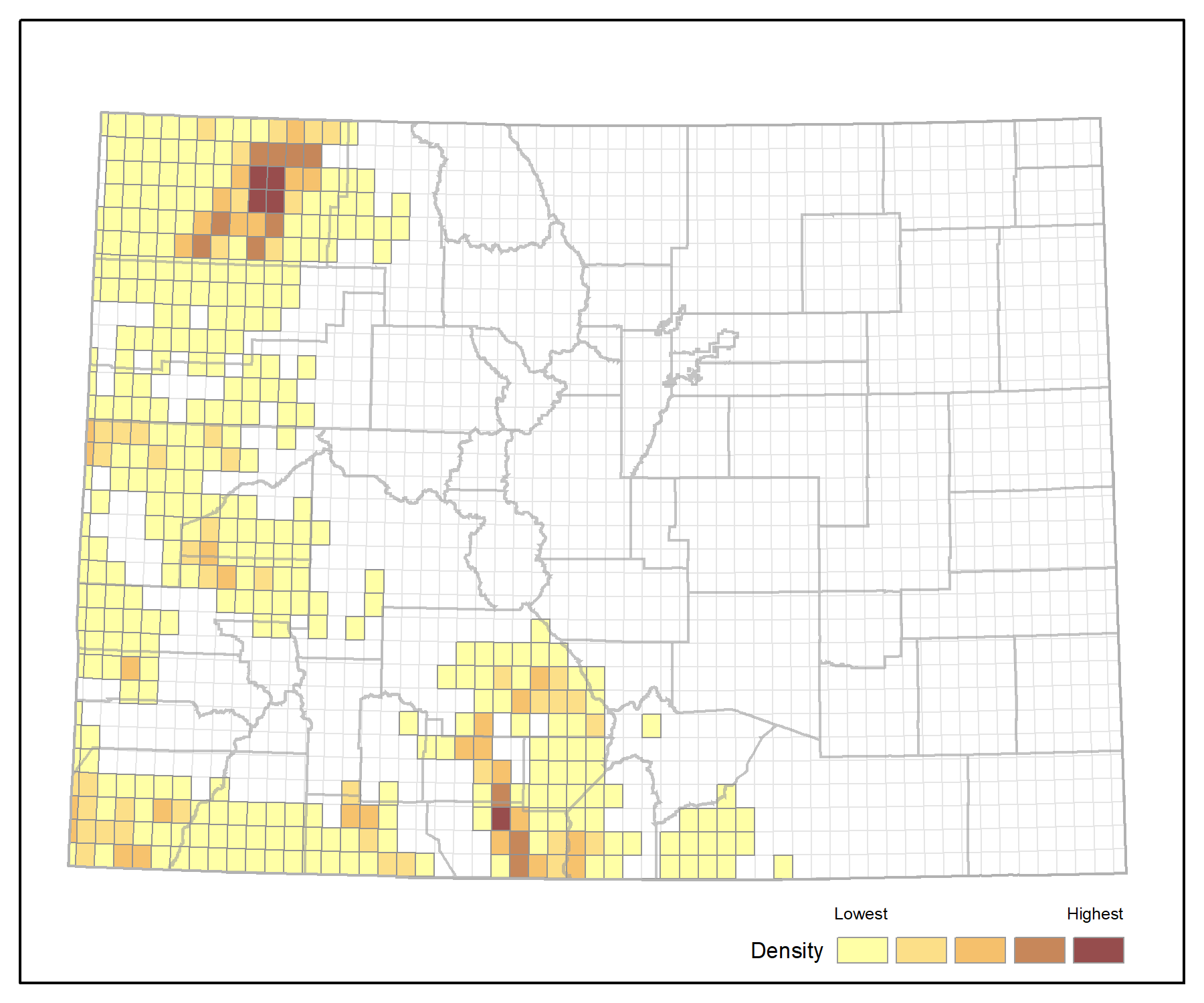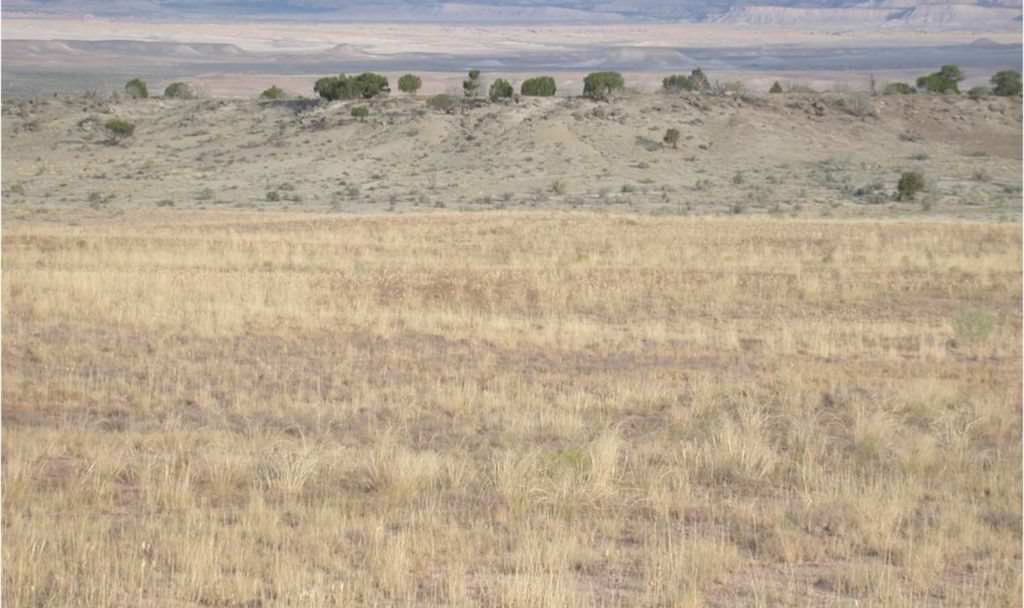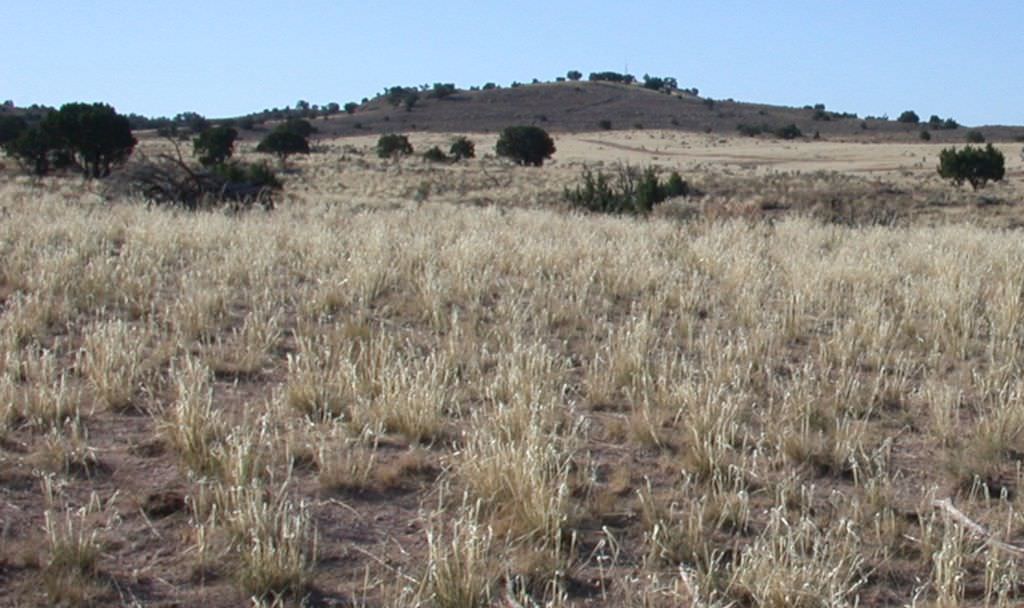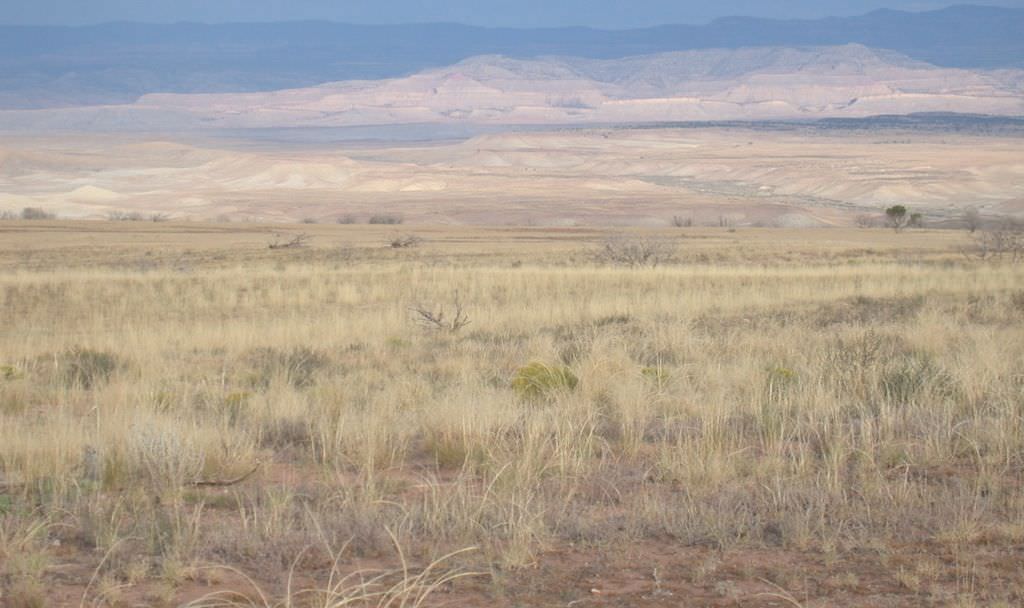Inter-Mountain Basins Semi-Desert Grassland
Click link below for details.
General Description
These widespread dry grasslands occur throughout the intermountain western U.S. as large patches in mosaics with shrubland systems dominated by sagebrush, saltbush, blackbrush, mormon-tea, and other shrub species. Colorado's semi-desert grasslands are found primarily on dry plains and mesas of the west slope at elevations of 1,450 to 2,320 m (4,750-7,600 ft). These grasslands occur in both lowland and upland areas and may occupy swales, playas, mesa tops, plateau parks, alluvial flats, and plains, but sites are typically xeric. Substrates are typically well-drained sandstone- or shale-derived soils. Some sandy soil occurrences have a high cover of biological soil crusts. Soil salinity depends on the amount and timing of precipitation and flooding. These grasslands are typically dominated by drought-resistant perennial bunch grasses such as Indian ricegrass (Achnatherum hymenoides), blue grama (Bouteloua gracilis), needle-and-thread (Hesperostipa comata), ring muhly (Muhlenbergia torreyi), James' galleta (Pleuraphis jamesii), or bluebunch wheatgrass (Pseudoroegneria spicata). Scattered shrubs and sub-shrubs may be present, including sagebrush (Artemisia spp.), saltbush (Atriplex spp.), jointfir (Ephedra spp.), snakeweed (Gutierrezia sarothrae), or winterfat (Krascheninnikovia lanata).
Diagnostic Characteristics
These grasslands are characterized by drought-resistant perennial bunch grasses forming open-canopied grasslands with widely scattered shrubs. Total cover is sparse to moderate, and areas of bare soil are likely to be common.
Similar Systems
Range
These widespread semi-desert grasslands occur throughout the intermountain western U.S. They are most common in the Colorado Plateau ecoregion. In Colorado semi-desert grasslands are found primarily on dry plains and mesas of the west slope, with some occurrences in the San Luis Valley or near the southern mountain front.
Ecological System Distribution

Spatial Pattern
Inter-Mountain Basins Semi-Desert Grassland is a large patch type.
Environment
West Slope low-elevation grasslands occur in semi-arid to arid climates with cold temperate conditions. Hot summers and cold winters with freezing temperatures and snow are common. Grasslands of the western valleys receive a significant portion of annual precipitation in July through October during the summer monsoon storms, with the rest falling as snow during the winter and early spring months. Annual precipitation is usually from 20-40 cm (8-16 in). Semi-desert grassland species are generally drought tolerant, and are adapted to low precipitation levels and a long growing season.
These grasslands occur in xeric lowland and upland areas and may occupy swales, playas, mesa tops, plateau parks, alluvial flats, and plains. Substrates are typically well-drained sandstone- or shale-derived soils. Soils are typically aridisols, which are dry for most of the year, even during the growing season, and there is little infiltration of water into the soil Some sandy soil occurrences have a high cover of cryptogams on the soil. Soil salinity depends on the amount and timing of precipitation and flooding.
Vegetation
These grasslands are typically dominated by drought-resistant perennial bunch grasses such as Indian ricegrass (Achnatherum hymenoides), blue grama (Bouteloua gracilis), needle-and-thread (Hesperostipa comata), ring muhly (Muhlenbergia torreyi), James' galleta (Pleuraphis jamesii), or bluebunch wheatgrass (Pseudoroegneria spicata). Scattered shrubs and sub-shrubs may be present, including sagebrush (Artemisia spp.), saltbush (Atriplex spp.), jointfir (Ephedra spp.), snakeweed (Gutierrezia sarothrae), or winterfat (Krascheninnikovia lanata). Blackbrush (Coleogyne ramosissima) is uncommon in Colorado occurrences, but typical further west.
- CEGL001652 Achnatherum hymenoides - Sporobolus contractus Grassland
- CEGL002343 Achnatherum hymenoides Colorado Plateau Grassland
- CEGL005800 Aristida purpurea Grassland
- CEGL001751 Bouteloua eriopoda - Pleuraphis jamesii Grassland
- CEGL001754 Bouteloua gracilis - Bouteloua curtipendula Grassland
- CEGL001755 Bouteloua gracilis - Bouteloua hirsuta Grassland
- CEGL005389 Bouteloua gracilis - Muhlenbergia torreyi - Aristida purpurea Grassland
- CEGL001759 Bouteloua gracilis - Pleuraphis jamesii Grassland
- CEGL001760 Bouteloua gracilis Grassland
- CEGL002588 Elymus lanceolatus Grassland
- CEGL003495 Ericameria nauseosa / Bouteloua gracilis Shrub Grassland
- CEGL001703 Hesperostipa comata - Achnatherum hymenoides Grassland
- CEGL001705 Hesperostipa comata Great Basin Grassland
- CEGL001708 Hesperostipa neomexicana Grassland
- CEGL001779 Muhlenbergia asperifolia Wet Meadow
- CEGL002363 Muhlenbergia pungens Grassland
- CEGL001778 Pleuraphis jamesii - Sporobolus airoides Grassland
- CEGL001777 Pleuraphis jamesii Grassland
- CEGL001657 Poa secunda Moist Meadow
- CEGL001674 Pseudoroegneria spicata - Achnatherum hymenoides Grassland
- CEGL001677 Pseudoroegneria spicata - Poa secunda Grassland
- CEGL001660 Pseudoroegneria spicata Grassland
- CEGL001661 Pseudoroegneria spicata ssp. inermis Grassland
- CEGL001688 Sporobolus airoides Monotype Wet Meadow
- CEGL001685 Sporobolus airoides Southern Plains Wet Meadow
Associated Animal Species
In contrast to the shortgrass prairie, these grasslands do not provide extensive animal habitat in Colorado. In areas near rocky outcrops, pallid bat (Antrozous pallida) is a typical resident. Gunnison's and white-tailed prairie dogs (Cynomys gunnisoni and C. leucurus), as well as other small burrowing or ground-dwelling animals provide prey for hawks (Buteo spp.). Burrowing Owl (Athene cunicularia), Vesper sparrow (Pooecetes gramineus), and other species of semi-arid areas may be seen. Sagebrush lizard (Sceloporus graciosus) and bullsnake (Pituophis catenifer) are likely to be common, and Great Basin spadefoot toad (Spea intermontana) may use small ponds within this habitat.
Dynamic Processes
This system is maintained by frequent fires that eliminate woody plants. A combination of precipitation, temperature, and soils limits this system to the lower elevations within the region. The dominant perennial bunch grasses and shrubs within this system are all highly drought-resistant. Grasses that dominate semi-arid grasslands develop a dense network of roots concentrated in the upper parts of the soil where rainfall penetrates most frequently.
The semi-desert grassland system is vulnerable to invasion by exotic species, particularly cheatgrass (Bromus tectorum). Although frequent fires in grasslands may have been common historically, the introduction of cheatgrass has altered the dynamics of the system, increasing both fire frequency and post-fire cheatgrass dominance. Cheatgrass is easily ignited, and also provides an abundance of fine fuels that carry fire.
Floristic composition in grasslands is influenced by both environmental factors and grazing history. Many grassland occurrences are already highly altered from pre-settlement condition. Grazing is generally believed to lead to the replacement of palatable species with less palatable ones more able to withstand grazing pressure. Grazing by domestic livestock may act to override or mask whatever natural climatic or edaphic mechanism is responsible for maintaining an occurrence. This habitat is also adapted to grazing and browsing by native herbivores including deer, elk, bison, and pronghorn, as well as burrowing and grazing by small mammals such as gophers, prairie dogs, rabbits, and ground squirrels. Activities of these animals can influence both vegetation structure and soil disturbance, potentially suppressing tree establishment. Periodic drought is common in the range of semi-desert grasslands, but may not be as great a factor in the vegetation dynamics of this system as in grasslands of the plains.
Management
Many areas that previously supported desert grasslands have been converted to agricultural use. Remnant stands of desert grasslands have been highly altered by livestock grazing, and it is likely that grasslands formerly occupied some sites that are now covered by pinyon-juniper or shrubland. Grazing by domestic livestock can also influence the relative proportion of cool- vs. warm-season grasses, or favor the increase of woody shrub species. Semi-desert grassland species are generally drought tolerant, and are adapted to low precipitation levels and a long growing season. Climate related vulnerability for these grasslands is minimal, but the impacted condition of many stands may inhibit their potential for expansion. Changes in the timing and amount of precipitation may affect the future composition and persistence of these grasslands.
References
- Asner, G.P. and K.B. Heidebrecht. 2005. Desertification alters regional ecosystem-climate interactions. Global Change Biology 11:182-194.
- Balch, J.K., B.A. Bradley, C.M. D'Antonio, and J. Gómez-Dans. 2013. Introduced annual grass increases regional fire activity across the arid western USA (1980-2009). Global Change Biology 19:173-183
- Brown, D.E., editor. 1994. Biotic Communities: Southwestern United States and Northwestern Mexico. University of Utah Press, Salt Lake City, UT.
- Debinski, D.M., H. Wickham, K. Kindscher, J.C. Caruthers, and M. Germino. 2010. Montane meadow change during drought varies with background hydrologic regime and plant functional group. Ecology 91:1672-1681.
- Dick-Peddie, W. A. 1993. New Mexico vegetation past present and future. Univ. of New Mexico Press. Albuquerque, New Mexico.
- Knapp, P.A. 1998. Spatio-temporal patterns of large grassland fires in the Intermountain West, USA. Global Ecology and Biogeography 7:259272.
- Munson, S.M., J. Belnap, C.D. Schelz, M. Moran, and T.W. Carolin. 2011. On the brink of change: plant responses to climate on the Colorado Plateau. Ecosphere 2:art68.
- Paulsen, H.A., Jr. 1975. Range management in the central and southern Rocky Mountains: a summary of the status of our knowledge by range ecosystems. USDA Forest Service Research Paper RM-154. Rocky Mountain Forest and Range Experiment Station, USDA Forest Service, Fort Collins, Colorado.
- Shinneman, D.J. and W.L. Baker. 2009. Environmental and climatic variables as potential drivers of post-fire cover of cheatgrass (Bromus tectorum) in seeded and unseeded semiarid ecosystems. International Journal of Wildland Fire 18:191-202.
- Sims, P.L., and P.G. Risser. 2000. Grasslands. Chapter 9 in: Barbour, M.G., and W.D. Billings, eds., North American Terrestrial Vegetation, Second Edition. Cambridge University Press, New York.
- Smith, D.R. 1967. Effects of cattle grazing on a ponderosa pine-bunchgrass range in Colorado. USDA Forest Service Technical Bulletin No. 1371. Rocky Mountain Forest and Range Experiment Station, USDA Forest Service, Fort Collins, Colorado.
- Stohlgren, T.J., L.D. Schell, and B. Vanden Huevel. 1999. How grazing and soil quality affect native and exotic plant diversity in rocky mountain grasslands. Ecological Applications 9:45-64.









